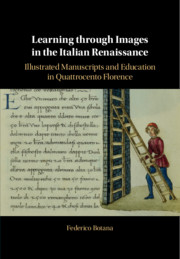
- Publisher:
- Cambridge University Press
- Online publication date:
- June 2020
- Print publication year:
- 2020
- Online ISBN:
- 9781108867313
- Subjects:
- Art, History, Western Art, History of Ideas and Intellectual History
Our systems are now restored following recent technical disruption, and we’re working hard to catch up on publishing. We apologise for the inconvenience caused. Find out more: https://www.cambridge.org/universitypress/about-us/news-and-blogs/cambridge-university-press-publishing-update-following-technical-disruption

For the affluent merchant class of fifteenth-century Florence, the education of future generations was a fundamental matter. Together with texts, images played an important role in the development of the young into adult citizens. In this book, Federico Botana demonstrates how illustrated manuscripts of vernacular texts read by the Florentine youth facilitated understanding and memorisation of basic principles and knowledge. They were an important means of acquiring skills then considered necessary to gain the respect of others, to prosper as merchants, and to participate in civic life. Botana focuses on illustrated texts that were widely read in Quattrocento Florence: the Fior di virtù (a moral treatise including a bestiary), the Esopo volgarizzato (Aesop's Fables in Tuscan), the Sfera by Goro Dati (a poem on cosmology and geography), and mathematical manuals known as libri d'abbaco. He elucidates, in light of original sources and medieval and modern cognitive theory, the mechanisms that empowered illustrations to transmit knowledge in the Italian Renaissance.
‘…[Botana’s] thoroughly researched study of illustrated pedagogical manuscripts uncovers a scholarly diet that was diverse, popular and above all practical, arising from the smut and noise of the urban street and the pragmatic requirements of business and civic life. ... Florence and its books, Botana shows, brimmed with character and life …'
James Waddell Source: The Times Literary Supplement
‘Botana has composed a thoughtful and compelling study of the illustrations that appeared in standard vernacular manuscript textbooks used to educate fifteenth-century Florentines in morals as well as practical computational skills, arguing that they show a careful attention to theories of learning and memory … He builds a convincing case that these sources were important participants in the visual and educational culture of Renaissance Florence, and remain as a resource that merits further study.’
Ann E. Moyer Source: Renaissance Quarterly
 Loading metrics...
Loading metrics...
* Views captured on Cambridge Core between #date#. This data will be updated every 24 hours.
Usage data cannot currently be displayed.